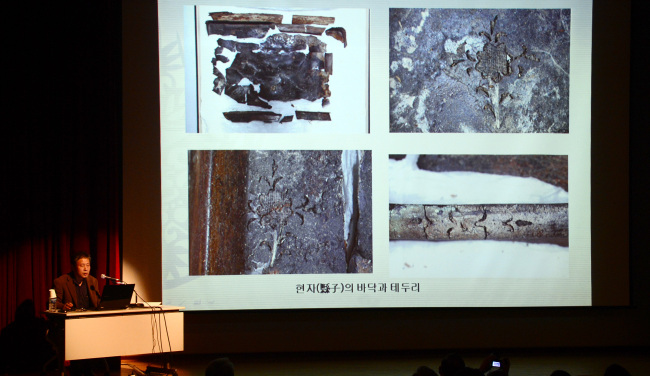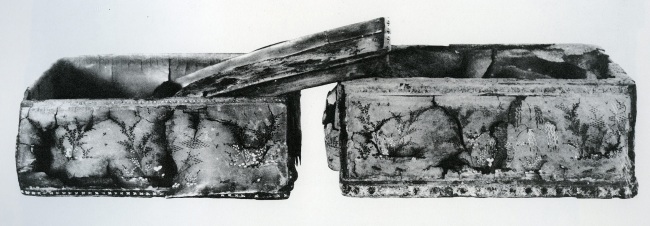Early Goryeo lacquer box under spotlight
The 12th-century Korean incense box offers insight into history of East Asian lacquerware
By Korea HeraldPublished : Dec. 1, 2013 - 19:08

An early Goryeo lacquer incense box was highlighted at an international symposium at the National Museum of Korea on Friday and Saturday, bringing art historians and scholars from Korea, China and Japan together to discuss the technical and artistic excellence of the item.
The symposium, organized by Asia Museum Institute, examined the 12th-century lacquer incense box decorated with plant and bird motifs in mother-of-pearl inlay and gold pigment.
Decorative and durable lacquerware makes up an important part of the craft culture of Korea, China and Japan. The oldest examples date from the second century B.C.

The lacquer box, from the collection of the National Museum of Korea, is currently in hundreds of broken pieces. First revealed in an art book published during the Japanese occupation in 1929, the box was damaged during the Korean War.
“In the history of Korean craft, there are not many craftworks left from the Goryeo Dynasty. But the early Goryeo lacquerware gives an insight into craftworks and history in early Goryeo,” said Kim Hong-nam, former director of the National Museum of Korea and director of the Asia Museum Institute.
“The study of the lacquer incense box also means a lot to the entire history of East Asian lacquerware,” Kim noted.
Jan Stuart, keeper of the Department of Asia at the British Museum, elaborated its implications for the history of East Asian lacquerware, citing a 12th-century Chinese lacquerware item decorated with mother-of-pearl inlay and gold paint that is similar to the Goryeo lacquer incense box examined at the symposium.
“You begin to develop a larger picture of the East Asian world ― what techniques were revealing to one country, to another, and what kinds of general tastes belong to a time period,” said Stuart, who gave a lecture on the British Museum’s research and collection of East Asian lacquerware in the symposium on Friday.
“In the history of Korean craft, there are not many craftworks left from the Goryeo Dynasty. But the early Goryeo lacquerware gives an insight into craftworks and history in early Goryeo,” said Kim Hong-nam, former director of the National Museum of Korea and director of the Asia Museum Institute.
“The study of the lacquer incense box also means a lot to the entire history of East Asian lacquerware,” Kim noted.
Jan Stuart, keeper of the Department of Asia at the British Museum, elaborated its implications for the history of East Asian lacquerware, citing a 12th-century Chinese lacquerware item decorated with mother-of-pearl inlay and gold paint that is similar to the Goryeo lacquer incense box examined at the symposium.
“You begin to develop a larger picture of the East Asian world ― what techniques were revealing to one country, to another, and what kinds of general tastes belong to a time period,” said Stuart, who gave a lecture on the British Museum’s research and collection of East Asian lacquerware in the symposium on Friday.

The early Goryeo lacquer box is noted for its elegance and luxuriousness, as the surface of the box is decorated in exquisite ornamental patterns, featuring willow trees, blooming bushes, chrysanthemums, peonies and ducks, according to the previous scientific examinations.
The style and techniques used in the incense box have been inherited from the lacquer tradition of Northern Song China (960-1126) and the gold painting is also considered to have been taken from China by the Goryeo craftsmen.
The AMI director Kim hopes the incense box to be recreated based on scholarly investigations.
“We may not see the shattered box being put together after we are done studying its structure and the techniques used, but we might be able to create a replica of the incense lacquer box,” said the AMI director Kim.
By Lee Woo-young (wylee@heraldcorp.com)
The style and techniques used in the incense box have been inherited from the lacquer tradition of Northern Song China (960-1126) and the gold painting is also considered to have been taken from China by the Goryeo craftsmen.
The AMI director Kim hopes the incense box to be recreated based on scholarly investigations.
“We may not see the shattered box being put together after we are done studying its structure and the techniques used, but we might be able to create a replica of the incense lacquer box,” said the AMI director Kim.
By Lee Woo-young (wylee@heraldcorp.com)
-
Articles by Korea Herald








![[KH Explains] Hyundai's full hybrid edge to pay off amid slow transition to pure EVs](http://res.heraldm.com/phpwas/restmb_idxmake.php?idx=644&simg=/content/image/2024/04/18/20240418050645_0.jpg&u=20240419100350)







![[From the Scene] Monks, Buddhists hail return of remains of Buddhas](http://res.heraldm.com/phpwas/restmb_idxmake.php?idx=652&simg=/content/image/2024/04/19/20240419050617_0.jpg&u=20240419175937)

![[KH Explains] Hyundai's full hybrid edge to pay off amid slow transition to pure EVs](http://res.heraldm.com/phpwas/restmb_idxmake.php?idx=652&simg=/content/image/2024/04/18/20240418050645_0.jpg&u=20240419100350)

![[Today’s K-pop] Illit drops debut single remix](http://res.heraldm.com/phpwas/restmb_idxmake.php?idx=642&simg=/content/image/2024/04/19/20240419050612_0.jpg&u=)